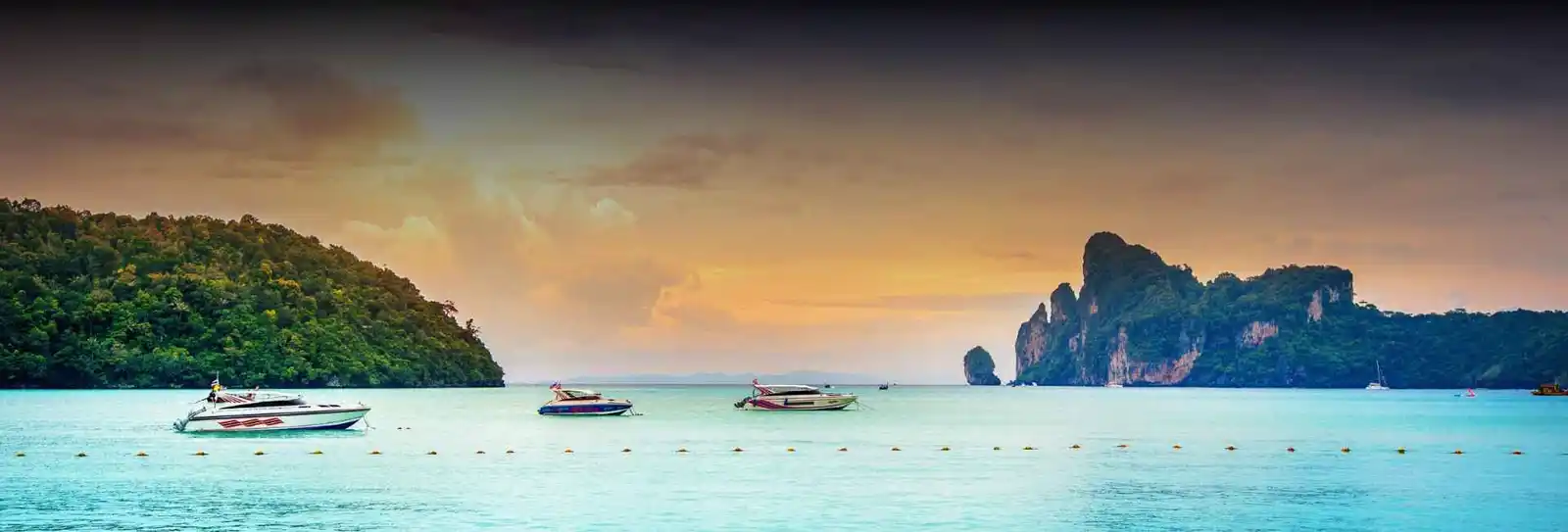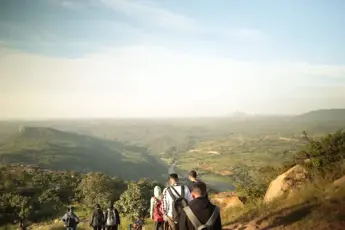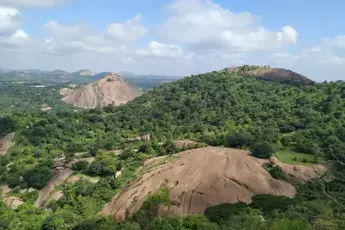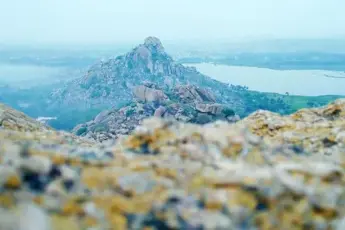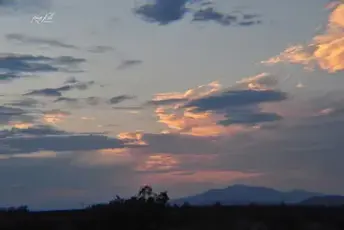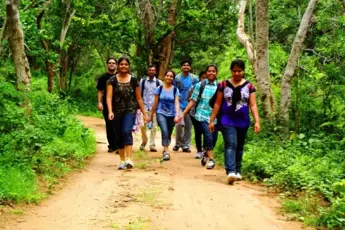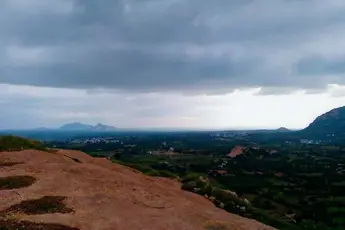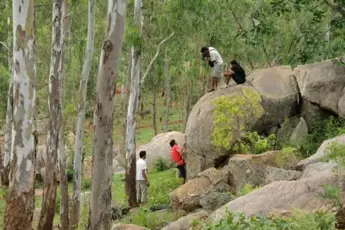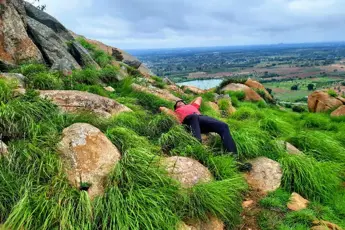
Aadrai Jungle Trek OverviewAmong the many hidden jewels Maharashtra offers to adventure lovers, lies the blissful and highly enthralling experience of adventure, on Aadrai Jungle Trek at the Western Ghats. This trek is located close to Malshej Ghat in the Pune district; explorers pass through thick greenery, cascading waterfalls, and misty landscapes. Aadrai Jungle is relatively untouched and unexplored. Unlike other popular treks, Aadrai retains its raw and mystical charm, providing an immersive experience of nature in its purest form.The trek is about 6-8 kilometres one way, which takes about 5-6 hours to complete. It is considered a moderate-level trek, thus ideal for both beginners and experienced trekkers. During the trek, trekkers are surrounded by streams that seem to appear from nowhere, hidden caves and the most spectacular views of the Sahyadri mountain range. The journey finally leads to the Kalu Waterfall, which is one of the main attractions of the trek, providing some of the most spectacular views during the monsoon season.Importance of the Western GhatsThe Sahyadri Hills, commonly known as the Western Ghats, are a UNESCO World Heritage site for the reason of great biodiversity and ecological importance. This mountain range extends along India's western coast, encompassing vast varieties of flora and fauna, many endemic, and endangered species. The region plays an important role in maintaining the climate of India's monsoons and contributes to supplying water to the rivers.The Aadrai Jungle is an important ecological hotspot of the Western Ghats. The dense forests provide shelter to different species of wildlife, such as leopards, deer, Malabar giant squirrels, and numerous birds and insects. The richness in biodiversity and uniqueness in the topography make the trek not just an adventure but also a way to experience the natural heritage of India.Historical and Cultural Background of Aadrai Jungle TrekTribal Heritage and CultureAadrai Jungle is connected with the tribal heritage and culture of such tribal communities as the Warli and Malvani, which have been living in the forests for centuries. White-on-mud paintings are very popular among the Warli tribals. This tribe has always been religiously attached to the forest because it is considered a dwelling place for divine spirits. Their cultural practices include the worship of trees, rivers, and animals, and they show animistic beliefs. The Malvani have their peculiar language, food, and folklore as the symbols of their life in the dense jungle and coastal area.Both groups depend on the forest for survival. They hunt, fish, and gather medicinal plants. They possess much knowledge regarding the flora and fauna, passed on through generations. Their houses, usually made of bamboo and dried leaves, are constructed in such a manner that they appear to be part of the environment. Dance and music form an integral part of their social events; the "Tarpa Dance" among the Warli and "Dashavtar" performances among the Malvani people are the usual ones. These traditions not only preserve their rich heritage but also give a glimpse of their community life, so close-knit.Folklore and MythsAadrai Jungle is full of myths and folklore, which add mystique to this place. There is a story that once a wandering sage meditated under a gigantic tree in the jungle and gained enlightenment. This continues, the villagers claim in believing he lingers still guarding the forest like a ghost, while a couple of others, to top everything off, are believed to be viewing shadowy shapes in that great thickening and trees and they assert is their own kind of ancestry left here.Another very popular legend is the "Guardian of the Aadrai," a mythical creature said to be like a large panther with glowing eyes, which only appears to lost travellers and leads them to safety. Legends also abound about the streams and waterfalls of the forest. Some say that the waters of the Aadrai Falls have healing properties, capable of curing ailments and rejuvenating the soul. The eerie quiet of the jungle, punctuated by the cries of birds, and rustling of leaves, further adds to a sense of mystique and wonder that these tales have surrounded it.History of the TrekAlthough a relatively recent trek for the modern trekker, the Aadrai Jungle Trek has its origins in ancient pathways that were used by tribal communities and local traders. Traditionally, jungle trails connected various settlements, providing a route for barter trade, especially in medicinal plants and forest produce. It was an ideal hiding place during historical conflicts, especially during the Maratha era when warriors sought refuge in its depths.This trek has garnered much popularity in the recent past among adventure and nature lovers primarily because of the breathtaking landscapes, waterfalls, and untamed biodiversity. A major part of the push came from the local trekking groups and social media as well, as people shared their awe-inspiring experiences. Today, the Aadrai Jungle Trek is sought after to experience Maharashtra's lush greenery, historical echoes, and cultural richness in the most immersive ways. It is still a place where nature and history blend seamlessly, preserving the essence of an ancient way of life amidst the modern trekking enthusiasm, despite its growing fame.Ecology and Biodiversity of Aadrai JungleAadrai Jungle, in the Western Ghats of Maharashtra, is a lush green paradise of rich biodiversity and highly dense forest covers. This pristine area contains varied flora and fauna, thus turning it into an ecological hotspot. The jungle with lush green, gushing waterfalls, and wildlife is significant for maintaining ecological balance in this region.Flora of Aadrai JungleThe Aadrai Jungle is highly rich in plant species, most of which are medicinally and ecologically important. The forest is mainly tropical evergreen and semi-evergreen, maintained by the high humidity and consistent rainfall characteristic of the Western Ghats. The tall teak (Tectona grandis), mahogany (Swietenia macrophylla), and different species of bamboo are some notable plant species found here. Some medicinal plants, such as Ashwagandha (Withania somnifera), Giloy (Tinospora cordifolia), and Adulsa (Justicia adhatoda), have been used traditionally in Ayurvedic medicine for their curative properties.Deeper into the forest are several endangered plant species like Orchids (Vanda spp.) and Myristica swamps. This Myristica swamp is one of the typical indicators of the region's health status. Aadrai Jungle supports the diverse flora that provides shelter and food to the wildlife; in addition, the flora has an important role in maintaining the water cycle and preventing soil erosion.Fauna of Aadrai JungleThe very dense vegetation that characterizes the Aadrai Jungle supports a wide and varied fauna, from predators at the highest level to even the smallest of insects. Such a majestic and elusive predator in the dense undergrowth is an Indian leopard. Other mammals widely found in this region are the wild boar (Sus scrofa), Indian giant squirrels (Ratufa indica), barking deer (Muntiacus muntjak), and langurs (Semnopithecus spp.). This shows that the jungle ecosystem is not in distress.Bird watchers have found Aadrai Jungle particularly rewarding because it accommodates an entire range of bird species, such as hornbills, Malabar whistling thrushes, crested serpent eagles, and paradise flycatchers. Several owl and nightjar species inhabit the jungle, so it's also a good destination for night bird enthusiasts. Besides, the ground floor and water bodies of the forest are inhabited by many species of amphibians and reptiles such as Indian rock pythons (Python molurus), monitor lizards, and several species of frogs that are endemic to this region of the Western Ghats. The beauty of butterflies, fireflies, and other insects is also contributing to the biodiversity wealth in Aadrai Jungle.User concludedDespite its ecological importance, the Aadrai Jungle still has significant conservation issues. Habitat fragmentation and human encroachment pose great threats to this delicate ecosystem, along with forest degradation. Some other major conservation issues are the problems of illicit logging and poaching. To avoid such threats, several conservation efforts have been carried out. Being a UNESCO World Heritage Site, Western Ghats is under constant observation by environmental organizations and the forest department. Afforestation programs, eco-tourism, and wildlife protection are some of the efforts that have been made to preserve the jungle's natural wealth.The local people hold crucial importance in the conservation process. The awareness programs teach the residents to be independent, reduce their reliance on forest resources, and develop sustainable practices. Several NGOs are involved in habitat restoration and biodiversity documentation for the protection of rare and endangered species. In a nutshell, the Aadrai Jungle is one of the most prominent ecological treasures that remain in the Western Ghats. Though there are numerous challenges to its conservation, hope prevails regarding saving this treasure because of the serious efforts by the environmental activists, local people, and the respective authorities. This forest is necessary not only to conserve its fauna but also a greater ecological equilibrium for human sustenance and living organisms.Overview of TrekkingOne begins trekking through dense forest, open grasslands, and rocky tracks, up to the highest point of 3,500 m on Summit Peak, from a base camp set at 1,200 m above sea level in the pretty village of Riverside, a fairly accessible drive away from the closest town. It covers a distance of nearly 45 kilometres, usually undertaken over four to five days. This depends on the fitness level and pace of the group.The trek is moderate to challenging in terms of difficulty. It satisfies the experience of trekkers as well as fit beginners who want to test their mettle. Although the initial stages are gentle slopes, the later ones are quite steep, with river crossings and many unpaved tracks that challenge endurance as well as balance.Important DetailsDuring the trek, one gets treated to breathtaking landscapes and remarkable natural wonders. Key highlights include:Emerald Falls: Stunning 80-meter falls where one can make a great resting stop.Misty Valley Viewpoint: Located at a height of 2,500 meters, this is a vantage point for panoramic views over rolling hills and distant mountain ranges.Crystal Stream: A fresh source of pure water where trekkers can refill their bottles with cool, clean drinking water.Dense Jungle Trail: A stretch of the track entirely leafy and covered by humongous trees with exotic birds and wildlife.Sunrise Ridge: A high-altitude ridge where trekkers can catch an unforgettable sunrise over the summits.Terrain and ChallengesA trek traverses different terrains, hence making it both exciting and challenging.Forest Trails: The trail is primarily covered with dense forests, and clear paths can be easily seen. It becomes very slippery during rainy seasons; therefore, proper footwear should be worn.Rocky Ascents: At the middle stretch of the trek, the road becomes rocky and uneven, hence caution is to be taken on every step.Muddy Patches: Portions of the track, especially in a river crossing, become muddy and slippery, so slow and cautious movement is expected.Steeper Inclines: Steep and almost constant ascents up to the final climb at Summit PeakRiver Crossings: Several crossings along the trek of knee-deep streamsSafety PrecautionsApprehended hazards on the route, which will require trekkers to exercise extra caution while making their ascentSlippery Trails: During and even after rainfalls, the path may become highly slippery. Properly fitted trekking shoes with high traction would be required.Wildlife Encounters: The dense sections of the jungle are home to a variety of wildlife, consisting of small mammals and birds. Trekkers should keep their distance and not feed animals.Altitude and Weather Conditions: As altitude gains, temperatures get significantly lower during the night. Proper layered dressing and acclimatization are helpful in not getting altitude sickness.Navigation and Hydration: Carrying a detailed map or GPS device is recommended, as certain paths can be confusing. Staying hydrated and packing sufficient energy snacks ensure sustained energy levels.Emergency Preparedness: Trekkers should carry a first aid kit, whistle, and emergency contact numbers in case of unforeseen incidents.Best Time to VisitThe best months for trekking usually lie between October and March. The weather conditions are generally cool and less wet, making the treks much safer and easier. October to November is also a post-monsoon period when the landscape is lush and green, and the trails are not too muddy. The climatic conditions during December to February offer cool climatic conditions that can be suitable for long treks when the temperatures can be tolerated and the humid levels are also low. March is the beginning of summer, but it can still be a workable time for trekking if the trekkers are well prepared for a few degrees of warmth. A trek taken after this period is particularly dangerous, especially when the rains set in from June to September with higher intense rainfall and slippery tracks accompanied by a larger number of leeches and other insects.Packaging EssentialsEffective packaging is paramount for an ideal trek. Sturdy, well-broken-in hiking boots are required for comfort and to avoid blisters on uneven terrain. Clothing should be lightweight and moisture-wicking with a wardrobe suitable for the jungle environment, ideally long sleeves and pants against insects and thorny bushes. A waterproof jacket is a must in such regions prone to sudden showers. Adequate water and energy-rich snacks, such as nuts and energy bars, are to be carried along with trekkers for hydration and fuel during the entire journey. A well-stocked first-aid kit, which should include bandages, antiseptic wipes, pain relievers, and personal medications, is indispensable in case of minor injuries. Moreover, a good flashlight or headlamp with extra batteries is essential for early morning or evening treks. Other essentials include insect repellent, a hat, sunscreen, and a lightweight backpack in case the most important things are needed to be carried while trekking.Physical Fitness RequirementsThe trekking activity is tiring. Hence, one needs to be prepared correctly. Cardiovascular exercise, such as jogging, cycling, or swimming, at least a month before the trek creates endurance. Strengthening one's muscles to give better stability in uneven paths requires exercising both the legs and the core. Exercising legs in squats, lunges, step-ups, planks, and sit-ups enhances the muscle building of core muscles, which helps to balance and posture. Preventive exercises, which would be a flex with the help of yoga, help in avoiding stiffened muscles and many other injuries. Exercising on terrains with loaded backpacks would simulate real conditions for hiking and thus help improve stamina. High-altitude treks should have aerobic activities built up progressively to increase lung capacity to prevent and reduce the potential of high-altitude sickness.Guides and Tour OperatorsHiring a local guide or trekking with a well-reputed tour operator greatly improves the trekking experience. The knowledge of a local guide concerning the terrain, flora, and fauna is richly rewarding on a trek. They also ensure that the trekkers take safe routes, avoiding chances of getting lost or experiencing unfavourable conditions. Guides are also often trained in first aid and emergency response, providing another security layer. The tour operators make logistical arrangements such as permits, accommodations, and meals, freeing the trekkers to focus only on enjoying the experience. Supporting local guides and operators also benefits the local economy and supports sustainable tourism. Whether trekking in remote areas or well-established trails, having an experienced guide can transform the journey into a memorable and hassle-free adventure.Preparation is key to a successful trek, from selecting the right season and packing light to staying fit and hiring good guides. A well-planned trek allows the trekkers to enjoy every moment of the beauty and challenges of the trail.Trekking ExperienceDay-to-Day ItineraryDay 1: Arrival and AcclimatizationTrekkers reach the base village and receive a briefing on the trek. The day acclimatizes at the altitude and climate, local surroundings, and preparation for adventure. Campfires and interaction sessions fix the rhythm of the journey.Day 2: Into the JungleThe journey starts at dawn through mountains which ascend gently. Above are towering trees, chirping birds, and fresh earth enveloping trekkers to go through narrow trails. Clearings provide periodic views of the valleys. The first camp is set up near a freshwater stream. Resting and rejuvenation under the same starlit sky.Day 3: Steep Trails and Hidden FallsThe trail becomes steeper as the gradient improves, but it has rocky edges. Some deep into the trek, waterfalls are seen to cool off within. This part of the hike begins alternating between thick foliage cover and open ridges that provide panoramic views. The day ends in a high-altitude campsite where a cool mountain breeze awaits.Day 4: The Final Push to the SummitThis is the toughest but most fulfilling part of the trek. The path is steep and rugged. When the final ascent is nearly made, there is a stark change in landscape from thick jungles to meagre vegetation. On reaching the top, a stunning sunrise can be seen through the Western Ghats. It is then spent some time stopping before descending through the same camp where they rested for the night.Day 5: Descending and GoodbyeThe descent is a mix of re-tracing some steps and discovering alternative routes that offer varied views of the same landscape. There are lovely meadows, leaves rustling sounds, and waterfalls in the distance. The trek culminates in the base village where the group meets to commemorate the experience shared before heading back home.Landscapes and ViewsThe trek is a treat of varied landscapes. The trek begins through dense tropical forests with tall, overarching trees and thick undergrowth to create an almost mystical atmosphere. As the trekkers climb higher, the forest opens up into rolling meadows revealing breathtaking vistas of the valleys. On the way, sparkling waterfalls cascade down moss-covered rocks, and narrow ridges offer fantastic views of peaks shrouded in mist disappearing into the horizon. The final stretch to the summit has a rocky terrain with patches of alpine vegetation. The view from the top over the undulating hills and sun-kissed ridges of the Western Ghats is something that will stay in your mind forever.Wildlife EncountersOne of the most thrilling aspects of this trek is seeing wildlife. The jungle hosts species from colourful butterflies and exotic birds to lesser-sighted mammals. Many times, trekkers see langurs swinging through the branches, hear the far-off calls of hornbills, and catch a glimpse of deer running through the trees. For those so lucky, they may even catch glimpses of the Malabar giant squirrel or even a wild boar. Once night falls, the forest itself becomes alive through the sounds produced by nocturnal creatures, leaving one with more than just memories of the overnight camp.Intricacies and Success StoriesTrekking in the Western Ghats may be as stressful as it's rewarding. Terrains vary- one needs so much stamina in case of extreme ascents over rocks and in the case of rocky descends. The weather is quite unpredictable, with sudden showers that make the trails slippery. Sections of dense forests and long hours of hiking test the physical and mental endurance of trekkers. However, the sense of accomplishment when reaching each milestone, especially the summit, is beyond compare. The camaraderie among trekkers, the breathtaking views, and the sheer joy of conquering nature's challenges make every struggle worthwhile. The trek not only builds endurance but also leaves participants with memories of adventure, discovery, and triumph over their limits.It's not only that the trekkers explore incredible landscapes; in addition, a trek also encompasses an immersion into rich cultural heritage while crossing over varied regions. Beneath the rugged trails, extensive forests, and mountainous ridges, one gets a lot of insights into the life led by local cultures, lifestyles, and rituals. A greater involvement with people living in remote areas of treks would infuse a true sense of enriching experiences along the route taken.Interaction with Locals: For many, one of the most fulfilling aspects is experiencing interaction with the native tribes and people. Many trekking routes pass by the remote villages where one gets a chance to visit the indigenous communities, which are some of the world's oldest settlers. Such interactions with the people allow one a glimpse of their way of life, traditional garments, their words, and folklore. Trekkers may have the chance to stay in local homestays, providing an authentic experience of the region's hospitality. This often includes tasting traditional foods, which are made using locally sourced ingredients and prepared using age-old techniques. For example, in Himalayan treks, travellers may enjoy momos and butter tea, while in South American trails, maize-based dishes are common.Beyond food, trekkers may witness or even participate in cultural rituals and celebrations. Festivals, dances, and music make significant happenings in many tribal communities. The ones who trek during festival seasons may be fortunate enough to witness or engage in the celebration activities. Whether it's a prayer ceremony at a Buddhist monastery, a dance by some African tribes, or hearing stories around a campfire, these experiences remain etched long after and infuse a sense of belonging among the people of the place.The Role of Local Communities in the TrekLocal communities are important in making trekking experiences possible. From guides and porters to lodge owners and artisans, they contribute a lot to the journey of the trekker. Many treks rely on experienced local guides who have extensive knowledge of the terrain, weather patterns, and historical and cultural significance of the area. These guides not only ensure a safe trekking experience but also share fascinating stories and legends associated with the trails.In addition to providing guidance, the local communities have essential services ranging from food to lodging. The majority of trekking lodges or tea houses run as family concerns, where people get to experience a cosy stay after an intense day of climbing. Food will often be quite traditional and use fresh produce; hence, providing the trekker with an original taste of what the region could offer. Furthermore, local communities are often involved in trail maintenance, ensuring that paths remain accessible and safe for travellers. Many conservation initiatives are led by indigenous groups who understand the ecological significance of their homeland and work to protect it from environmental degradation. By supporting local businesses and respecting their customs, trekkers contribute to the sustainability of these communities.Spiritual SignificanceMountains, forests, and rivers along trekking routes hold deep spiritual and religious significance for many local communities. Certain trails pass through sacred groves, ancient temples, or monasteries that have been places of worship for centuries. So also with pilgrimage routes like the Camino de Santiago in Spain or the Kailash Mansarovar Yatra in Tibet.Even in regions without formal religious structures, nature itself is often revered. Many indigenous groups consider the mountains or forests to be the abode of spirits or deities. Rituals may be performed to honour these natural elements, and trekkers may be invited to participate or observe. Respecting these traditions and being mindful of cultural sensitivities enhances the trekking experience and fosters a deeper appreciation for the land and its people.Accommodation and Food OptionsCamping and Rest StopsTrekking through the serene landscapes of Maharashtra offers an incredible opportunity to camp under the stars and connect with nature. Along the trek routes, trekkers have the option of staying in tents, which are either provided by tour organizers or brought along by trekkers themselves. Many trekking groups have set up designated camping spots near streams, clearings, or plateau regions that offer a safe and comfortable overnight stay. Some popular treks have makeshift shelters or small huts built by locals, which provide basic protection from the elements. It involves camping in the wild, being surrounded by nature, where stars illuminate the night sky, and the sounds of the forest give a feel to the trek. A campfire is usually made, which is an excellent place for bonding with fellow trekkers as one shares stories, warms himself, and takes in the fresh mountain air.Food During the TrekFood is an important factor in any trek because it provides one with the required energy to complete the physically demanding journey. Most trekking packages have simple, however nutritious meals. Among these, local dishes such as khichdi (a mix of rice and lentils), dal-rice, poha, upma and chapati with vegetable curry are eaten. These food items are wholesome, and designed for sustenance needed during trekking. At times, small stalls offering freshly cooked meals, tea, and snacks such as vada pav and bhajia, run by local villagers, are a lovely regional flavour to the experience. An integral part of trekking is a shared eating experience in which participants sit together to share meals, hear stories, and connect over adventure. Users of drinking water have to rely on natural springs or carry bottles with them, and trekkers are advised to use purification tablets before consumption.Accommodation before and after the trekIf trekkers want a comfortable overnight stay before or after the trek, nearby towns and base villages, such as Igatpuri and Jawhar, offer plenty of accommodation. There are budget-friendly guesthouses and homestays that provide a snug, cosy, and affordable stay run by local families whose home-cooked meals render very warm hospitality. These opportunities enable trekkers to be part of authentic local culture and traditions. Comfort-seekers may opt for resorts and hotels in the area, which provide comforts such as hot showers and comfortable bedding along with panoramic views of the surrounding hills. Some resorts cater specifically to trekkers, providing early morning breakfast services, transport assistance, and guided trek packages. Staying in these accommodations before a trek allows for proper rest and acclimatization, while a post-trek stay provides relaxation and rejuvenation after a physically demanding journey. Whether one takes up rustic camping under the starry sky or a well-decorated guesthouse, this perfect blend of adventure and hospitality makes the experience unforgettable.Trekking Responsible for the EnvironmentTrekking and adventure tourism have gained much momentum and are gradually generating revenue within the local economy, but are causing serious problems for the environment. The ecosystem suffers from several issues such as deforestation, pollution, and habitat destruction resulting from tourism, especially in weak natural environments. However, sustainable trekking with proper conservation techniques can help limit these impacts while keeping nature in good condition for future generations.Impact of Tourism on the EcosystemWith increased tourism in mountainous and remote areas, several environmental issues have emerged. Among these, the first and foremost issue is deforestation. In building lodges, trails, and campsites, trees are usually cut down, which results in soil erosion and loss of biodiversity. In addition, foot traffic on trails leads to soil compaction, thereby disrupting plant growth and land degradation. The other critical issues relate to waste disposal because if mishandled, plastic waste, food wrappers, and other non-biodegradable materials pollute the surrounding environments. In addition, the overuse of detergents, soaps, and human excreta contaminates water sources in trekking areas, posing a risk to both wildlife and the local communities dependent upon them for survival.Many national parks and local governments have implemented regulations that include the permit system, waste management initiatives, and enforcing very strict guidelines for trekkers. Safe and responsible tourism is encouraged through these eco-tourism policies that limit tourists in sensitive areas, promote sustainable accommodations, and educate trekkers about the importance of conservation.Practices Regarding Sustainable TreksResponsible trekking is the only way to maintain the natural environment. One of the most important principles of responsible trekking is the Leave No Trace (LNT) guidelines. This includes taking all waste, staying on designated trails to avoid soil erosion, and camping in established areas to minimize human impact. Single-use plastics should also be avoided, and reusable water bottles, cloth bags, and biodegradable products should be used instead.Respecting wildlife is another important concept in sustainable trekking. To adjust their natural lifestyles, feeding and disturbing animals should not be made a habit or dependency on them. Long-lasting ecological imbalances can be prevented by observing these animals from a distance and not generating loud noises along with litter in their habitats by the trekkers. Another significant way is reducing the carbon footprint by choosing eco-friendly trekking options, such as using solar-powered devices and supporting local businesses that practice sustainability. There is also conservation of precious natural resources related to water usage and avoiding contamination of streams and lakes.Role of Trekking Groups and NGOsMany trekking groups and environmental organizations are actively involved in the preservation of natural landscapes. These NGOs, including Leave No Trace, The International Ecotourism Society (TIES), and local conservation groups, conduct awareness programs, organize clean-up drives, and advocate responsible trekking practices in many trekking destinations. In community-based tourism initiatives around the trekking destination, residents are involved in conservation efforts while ensuring that they benefit from tourism while preserving their cultural heritage and environment.Additionally, some trekking companies and guides emphasize eco-tourism by incorporating sustainable practices into their itineraries. They enforce strict waste management policies, educate trekkers about environmental preservation, and contribute to reforestation projects. Responsible trekking is not only the responsibility of individuals but also a team effort. This can be ensured by taking cognizance of our environment and adopting sustainable ways of practices. We must help in conservation to ensure that these trekking places remain clean and enjoyable for ages to come.How to Reach Aadrai Jungle TrekBy Road:From Mumbai:Distance: About 150-170 km, approx. 3-4 hours by car.Route: You can take the NH3 (National Highway 3) from Mumbai, passing through Thane, and Bhiwandi, and then head towards Igatpuri. From Igatpuri, the route will take you to the Aadrai Jungle base.Best Option: You can take a private vehicle on rent or a comfortable taxi. You can also opt for public buses or shared taxis.From Pune:Distance: About 200-220 km (around 4-5 hours by car).Route: Pune to Nashik via Pune-Nashik Highway (NH60). From Nashik, move toward Igatpuri. Further, it takes you to the Aadrai Jungle base. The road is really beautiful as you drive through the Western Ghats.From Nashik:Distance: Around 65 km. It would take 1.5 to 2 hours by car.Route: Take the Mumbai-Agra Highway, NH3 to Igatpuri from Nashik. It takes around half an hour's drive by local transport - bus, taxi, or even a private vehicle-to reach Igatpuri, where you'll find your trek base. By Train:Nearest Railway Stations:Igatpuri Railway Station: The nearest major railway station is Igatpuri, about 15 km from the trek base. Igatpuri is well-connected to Mumbai, Pune, Nashik, and other major cities.Nashik Railway Station: If you are coming from Nashik, then you can get a train up to Igatpuri or a nearby station.Igatpuri Railway Station to Aadrai Jungle: You may hire a taxi or a local vehicle from Igatpuri to reach the starting point of the Aadrai Jungle Trek. Local buses and auto-rickshaws could also be managed.By Airport:Nearest Airport:The nearest airport is Chhatrapati Shivaji International Airport (Mumbai), which lies at a distance of about 150-170 km from Aadrai Jungle.A further alternative option is the Ozar Airport at Nashik. The airport is 80km away from the trek. Since there are fewer numbers of flights available to the Ozar airport, it cannot be considered comparable to Mumbai as it is very poorly connected. Airport Transportation:Mumbai and Nashik airports receive domestic flights.Taxis and cars on hire, apart from other possible means of transport can be available for Igatpuri where the trek route will begin.Places within reach of the destinationOther places to visit while travelling to Aadrai Jungle Trek are the following-that are nearby with nice landscapes, historical places, and cultural experiences. Some of them are given below:1. Igatpuri:Distance from Aadrai Jungle: About 15 kmWhy Visit: Igatpuri is a popular hill station and a great base for starting the Aadrai Jungle Trek. It is famous for its scenic beauty, lush green hills, and pleasant weather.Attractions:Tringalwadi Fort: It is a historical fort located on a hilltop, offering panoramic views of the surrounding area.Bhatsa River Valley: It is a serene valley with stunning views and is perfect for photography.Ghatandevi Temple: It is a beautiful temple located amidst the hills, offering tranquillity and scenic views.2. Nashik:Distance from Aadrai Jungle: Approximately 65 kmWhy Visit: Nashik is one of the significant religious and cultural cities near the Western Ghats. It has a lot to offer in the way of temples, vineyards, and history.Attractions:Trimbakeshwar Temple: One of the 12 Jyotirlingas of India, a very religious site.Saptashrungi: Mountain range and a temple of Goddess Saptashrungi about 60 km from Nashik.Nashik Vineyards: Nashik region is famous for the wine-making business. You may visit Sula Vineyards to taste wines.3. Kalsubai Peak:From Aadrai Jungle: 50 kmWhy It's Worth a Visit: Kalsubai is the highest peak in Maharashtra with a height of 1,646 meters. It is a great trek and offers panoramic views.Attractions:Kalsubai Temple: A small temple at the summit dedicated to the goddess of that region.Trekking Experience: Known for its steep climbs, Kalsubai offers a great trekking experience with breathtaking views of the surrounding valleys and hills.4. Jawhar:Distance from Aadrai Jungle: About 50 kmWhy Visit: Jawhar is a hill station in the Palghar district, known for its picturesque views, waterfalls, and vibrant tribal culture.Attractions:Shirpamal: A viewpoint offering a stunning view of the surrounding valley and hills.Dabhosa Waterfall: One of the biggest waterfalls in the region, perfect for a relaxing day out.Tribal Culture: Jawhar is inhabited by the Warli tribe, famous for their distinct art and culture.5. Anjneri Hill:Distance from Aadrai Jungle: Approximately 40 kmWhy Visit: Anjneri Hill is said to be the birthplace of Lord Hanuman. It is a great place for nature lovers and history buffs.Attractions:Anjneri Fort: A historical fort on the hill offering panoramic views of the surrounding region.Hanuman Temple: The temple at the top is a pilgrimage site, and it also offers a challenging but rewarding trek.6. Bhandardara:Distance from Aadrai Jungle: About 70 kmWhy Visit: Bhandardara is a scenic hill station and a popular weekend getaway. It is known for its beautiful lakes, waterfalls, and serene surroundings.Attractions:Arthur Lake: A scenic lake with hills around it, suitable for a boat ride.Randha Falls: Close to Bhandardara, the wonderful waterfall is just perfect for nature lovers.Wilson Dam: The old dam near the lake is great to take clear views and enjoy a peaceful space.


